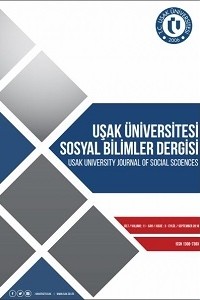İç Anadolu Bölgesi Ağızlarında Geçen İkilemeler Üzerine Bir Değerlendirme
Dilimizin zengin söz varlığı içerisinde yer alan ikilemeler, genellikle anlamı pekiştirmek, güçlendirmek için oluşturulmuş sözcük grupları olarak tanımlanır. Başlı başına yeni bir kelime türetme yolu olarak da değerlendirilen bu sözcük gruplarını özellikle yapılışları ve cümle içindeki görevleri yönünden üzerinde çalışılması gereken bir konu diye düşünmekteyiz. Ayrıca metinlerde geçen ikileme örneklerinin ait olduğu dilin söz varlığına da katkısı tartışılmazdır. Bu düşünceden yola çıkarak çalışmamızda İç Anadolu Bölgesi’nde yer alan 13 ile ait derlenmiş ağız metinlerini tarayarak bölge ağızlarında geçen ikilemeleri tespit ettik. Öncelikle ikilemenin tanımı üzerinde durduk. Bugüne kadar yapılan çalışmalardan ikilemeyle ilgili literatür taraması yaparak ikilemenin tanımı ve özellikleri üzerinde ayrıntılı bir şekilde durmaya çalıştık. Konuyla ilgili yapılmış diğer çalışmalarda ikileme yerine kullanılan tekrarlar, yinelemeler, ikizleme gibi faklı terimlerin varlığından söz ettik.
Anahtar Kelimeler:
İkileme, tekrarlar, hendiadyoin, İç Anadolu, ağız, Türkçe.
An Evaluation Research On Reduplications Aforesaid İn Central Anatolian Region Dialects
Reduplications, taking place in our tongue’s rich vocabulary are usually defined as phrases created for reinforcement and strengthen the meaning. We consider these phrases, which is also seen as a new word formation method in itself, as a worth stressing subject especially on formation and intra sentence functions. Furthermore, it is out of debate that reduplication examples mentioned in texts contribute to the tongue’s vocabulary. With this in mind, in our study with scanning compiled dialect texts belonging to 13 provinces of Central Anatolian Region we ascertained reduplications mentioned in regions dialects. First of all, we emphasized on the definition of reduplication. We tried to emphasize on the definition and functions of reduplication in detail by reviewing the literature of the ever made studies related to the subject. We mentioned about the entity of repetitions, reiterations, and doublings which were used as substitutes in other related studies. Later on, we arranged the reduplications that we ascertained before according to the provinces and analyzed these examples under two main topics; formation and word class. With sub-headings, we tried to explain all the different functions and formations manners of the reduplications mentioned in the texts. While analyzing, we begin with the common explanation of the heading, and then give reduplication examples that were previously ascertained from the region dialects, related with the heading. All the reduplications found during text scanning, regardless of existence in written language, are made card index. When all the reduplications were revealed, it is seen that some of the reduplications which were not present in our written language continued its existence in Central Anatolian dialects. On that sense we are of the opinion that this study will contribute to the field of Turcology from a differ
Keywords:
Reduplication, repetitions, handiadyoin, Central Anatolia, dialect, Turkish,
- ISSN: 1308-738X
- Başlangıç: 2015
- Yayıncı: Uşak Üniversitesi
Sayıdaki Diğer Makaleler
A Case Study: Language Needs of Electric-Electronics Students
Algı Haritaları ve Marka Konumlandırma: Dizüstü Bilgisayar Markaları Üzerine Bir Çalışma
Toplumsal Bir Hastalık: Sosyal Kaytarma
Kültürel Din Psikolojisi Açısından Geçiş Dönemi Rüyaları: Kutadgu Bilig Örneği
Öğrencilerin Pazarlama Mesleğini Seçme Nedenlerinin İncelenmesi: Harmancık Meslek Yüksekokulu Örneği
İç Anadolu Bölgesi Ağızlarında Geçen İkilemeler Üzerine Bir Değerlendirme
İmkb'ye Kote Edilmiş Havayolu Taşimaciliği Sektöründe Trend Analizine İlişkin Örnek Bir Uygulama
